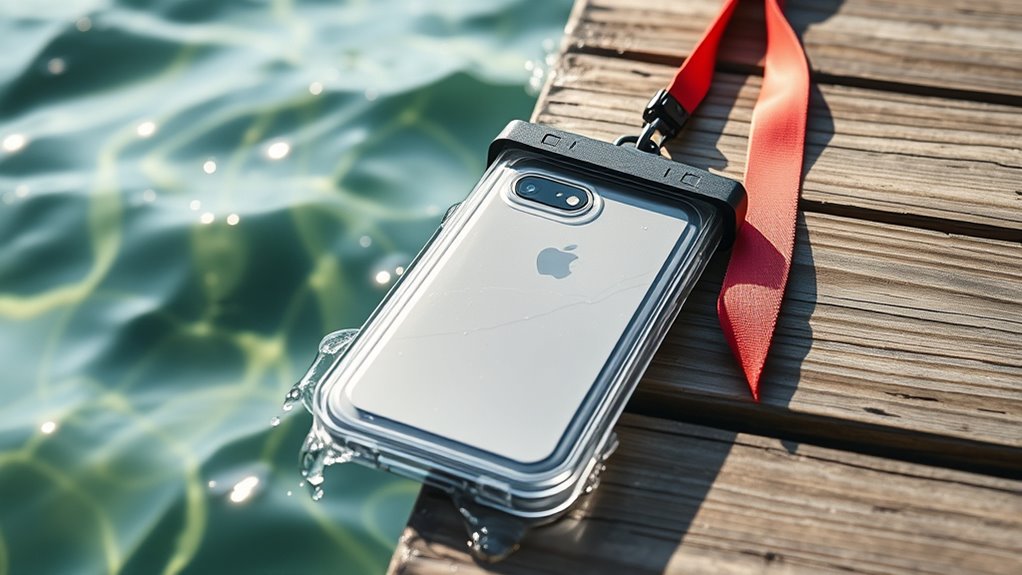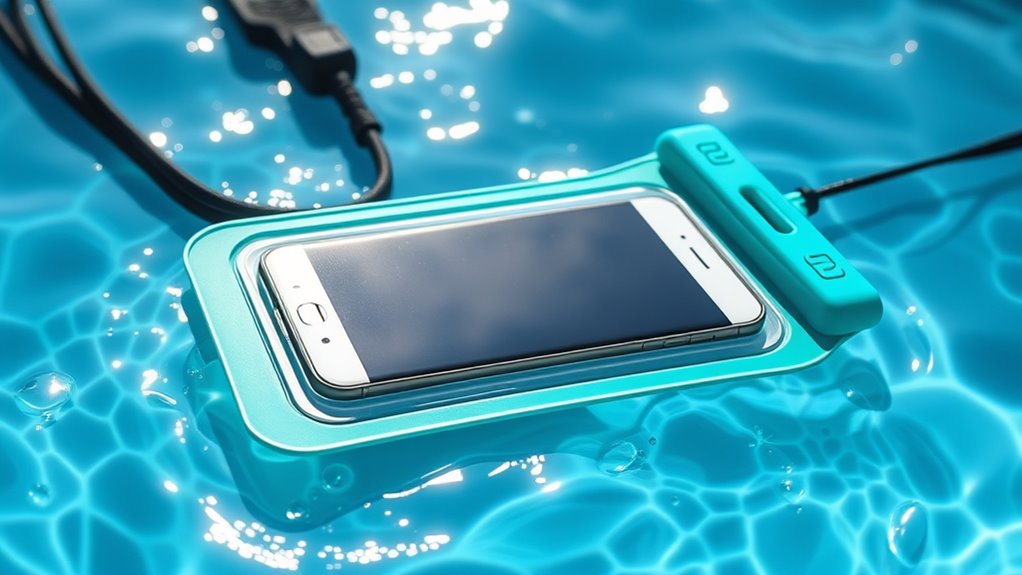Waterproof phone cases and lanyards keep your devices safe by creating tight seals that block water, dirt, and drops. They use durable materials like reinforced corners and rubber gaskets to guarantee protection during activities like swimming or outdoor adventures. Properly sealed and maintained, these accessories prevent water from reaching your phone. To learn how to choose and care for them effectively, keep exploring how these solutions work to keep your tech safe.
Key Takeaways
- Effective waterproof cases feature high IP ratings (like IP68) and secure locking mechanisms to prevent water ingress during submersion.
- Proper sealing, including port covers and rubber gaskets, is essential to maintain water resistance.
- Lanyards provide secure attachment and easy access, reducing the risk of drops and ensuring device safety.
- Regular inspection and maintenance of seals and locks prevent water entry and preserve waterproof integrity.
- Following manufacturer guidelines for installation, use, and submerged limits maximizes device protection.

Whether you’re heading to the beach, hitting the pool, or simply want to protect your phone from everyday splashes, waterproof phone cases and lanyards offer a practical solution. These accessories are designed to keep your device safe from water, dirt, and accidental drops, giving you peace of mind in various environments. But not all waterproof cases are created equal, and understanding what makes some more effective than others can help you choose the right protection.
Waterproof phone cases and lanyards protect your device from water, dirt, and drops in various environments.
A good waterproof case forms a tight seal around your phone, preventing water from seeping in. Look for cases with high-quality materials like durable polycarbonate shells, reinforced corners, and secure locking mechanisms. Many cases feature a port cover or rubber gaskets that block entry points for water and dust, ensuring your device stays dry even when submerged. It’s vital to verify the waterproof rating—commonly expressed as IP (Ingress Protection) ratings—so you know exactly how deep and long your phone can stay underwater safely. For everyday use, an IP68 rating is usually recommended, meaning the case can withstand immersion in water beyond 1 meter for at least 30 minutes.
Lanyards complement waterproof cases by providing a convenient way to keep your phone within reach without risking accidental drops. When choosing a lanyard, prioritize adjustable, sturdy straps made from materials like nylon or leather, which can withstand daily wear. Many lanyards attach securely to the case via sturdy clips or loops, so you don’t have to worry about your phone slipping out during active moments. Some lanyards also come with additional features, like waterproof pouches or extra pockets for cards and cash, adding extra layers of convenience and protection.
In terms of actual protection, the most reliable waterproof cases are tested and certified, meaning they’ve gone through rigorous quality control to ensure they meet safety standards. Always check reviews and product specifications before buying, because even a well-designed case can fail if it’s not properly sealed or if the locking mechanism isn’t secure. Proper installation is equally important—double-check that the case is snapped shut completely and that all seals are intact before exposing your phone to water.
Taking care of your waterproof case and lanyard is simple. Regularly clean and inspect the seals for debris or damage, and replace any worn-out parts promptly. This maintenance helps ensure that your device remains protected over time. Remember, while waterproof cases and lanyards greatly reduce the risk of water damage, no solution is entirely foolproof. It’s wise to avoid exposing your phone to water unnecessarily, even if it’s encased, and always follow the manufacturer’s guidelines for usage and submerged depths. Properly sealed and certified accessories provide an added layer of security, but understanding the waterproof rating and maintenance needs is essential for lasting protection. Ultimately, choosing high-quality, certified accessories and maintaining them properly keeps your tech safe and functional, no matter where your adventures take you.
Frequently Asked Questions
How Do Waterproof Cases Affect Phone Touchscreen Sensitivity?
Waterproof cases can slightly reduce your phone’s touchscreen sensitivity, especially if they use thicker or more rigid materials. You might notice a bit less responsiveness or difficulty swiping, but many modern cases are designed with sensitive touchscreens in mind. To minimize issues, choose a case with a high-quality, transparent material that maintains screen responsiveness, and make certain there’s no dirt or moisture trapped between your phone and the case.
Are Waterproof Cases Suitable for Extreme Underwater Depths?
Yes, waterproof cases are suitable for extreme underwater depths, but you need to verify their specifications. Most cases are rated for specific depths, often around 6 to 30 meters. If you plan to go deeper, look for cases designed for professional diving. Always test your case before submerging your phone fully, and make sure all seals are secure to prevent water ingress at greater depths.
Can Waterproof Cases Be Reused After Exposure to Saltwater?
Yes, you can reuse waterproof cases after exposure to saltwater, but you should thoroughly rinse them with fresh water to remove salt residue. Salt can corrode seals and damage the case over time, so inspect it carefully for cracks or wear before reuse. Make sure the case is completely dry and airtight to maintain its waterproof integrity. Proper cleaning and regular checks help ensure your device stays protected during future adventures.
Do Waterproof Lanyards Prevent Accidental Drops Effectively?
Think of a waterproof lanyard as your tech’s personal bodyguard—sure, it’s not invincible, but it definitely keeps your device from taking an unplanned plunge. While it won’t turn your phone into a superhero, it does reduce accidental drops markedly, especially when you’re rushing or distracted. So, yes, a good lanyard acts like a safety net, giving you peace of mind and saving you from embarrassing phone ejections in public.
How Often Should Waterproof Phone Cases Be Tested for Integrity?
You should test your waterproof phone case at least once every few months, especially before outdoor adventures or water activities. Check the seals and closures for any signs of wear or damage, and perform a quick water test if unsure. Regular testing guarantees the case maintains its integrity, giving you peace of mind that your device stays dry and safe during use. Don’t skip this simple but essential step for protection.
Conclusion
When choosing waterproof phone cases and lanyards, you’re like a captain steering your tech through rough waters. They’re your first line of defense, keeping your device safe from splashes, drops, and dust. Remember, no single solution is foolproof, so combine them for the best protection. With the right gear, your phone stays secure and ready, just like a trusty boat sailing smoothly no matter what comes its way.









